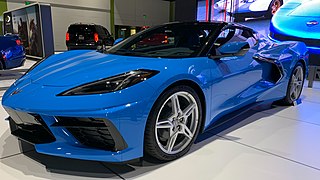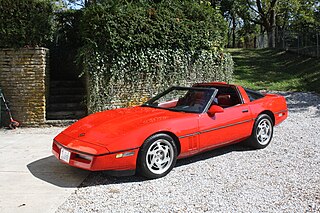
The Chevrolet Corvette, colloquially known as the 'Vette, is a two-door, two-passenger luxury sports car manufactured and marketed by Chevrolet across more than 60 years of production and eight design generations. From 1953 to 2019, it was front-engined, and since 2020, it is mid-engined. With its generations noted sequentially from C1 to C8, the Corvette serves as Chevrolet's halo vehicle and is noted for its performance and distinctive plastic bodywork, either fiberglass or composite.

The Chevrolet Impala is a full-sized car built by Chevrolet for model years 1958 to 1985, 1994 to 1996, and 2000 to 2020. The Impala was Chevrolet's popular flagship passenger car and was among the better-selling American-made automobiles in the United States.

The Chevrolet Corvair is a compact car manufactured by Chevrolet for model years 1960–1969 in two generations. It remains the only American-designed, mass-produced passenger car with a rear-mounted, air-cooled engine. The Corvair was manufactured and marketed in 4-door sedan, 2-door coupe, convertible, 4-door station wagon, passenger van, commercial van, and pickup truck body styles in its first generation (1960–1964) and as a 2-door coupe, convertible or 4-door hardtop in its second (1965–1969) – with a total production of approximately 1.8 million from 1960–1969.

The Chevrolet Bel Air is a full-size car that was produced by Chevrolet for the 1950–1975 model years. Initially, only the two-door hardtops in the Chevrolet model range were designated with the Bel Air name from 1950 to 1952. With the 1953 model year, the Bel Air name was changed from a designation for a unique body shape to a premium level of trim applied across a number of body styles. The Bel Air continued with various other trim level designations, and it went from a mid-level trim car to a budget fleet sedan when U.S. production ceased in 1975. Production continued in Canada, for its home market only, through the 1981 model year.

The Opel GT is a front-engine, rear-drive two-seat sports car manufactured and marketed by Opel in two generations — separated by a 34-year hiatus.
The Pontiac Banshee is a line of concept cars designed by Pontiac, assuming the role previously established by General Motors' Firebirds of the 1950s. Four Banshee "dream cars" were fabricated through 1988 as design exercises intended to establish exterior and interior themes that could be modified for production versions of Pontiac sports and performance cars. Banshee was also the leading candidate for Pontiac's version of the Camaro before being named Firebird in light of any deathly associations of the word Banshee.

Chevrolet Nomad is a nameplate used by Chevrolet in North America from the 1950s to the 1970s, applied largely to station wagons. Three different Nomads were produced as a distinct model line, with Chevrolet subsequently using the name as a trim package.

The Chevrolet Corvette (C2) is the second generation of the Chevrolet Corvette sports car, produced by the Chevrolet division of General Motors for the 1963 through 1967 model years.

The Chevrolet Corvette (C3) is a sports car that was produced from 1967 until 1982 by Chevrolet for the 1968 to 1982 model years. Engines and chassis components were mostly carried over from the previous generation, but the body and interior were new. It set new sales records with 53,807 produced for the 1979 model year. The C3 is the third generation of the Chevrolet Corvette, and marks the second time the Corvette would carry the Stingray name, though only for the 1969 - 1976 model years. This time it was a single word as opposed to Sting Ray as used for the 1963 - 1967 C2 generation. The name would then be retired until 2014 when it returned with the release of the C7.

The Chevrolet Corvette (C4) is a sports car produced by American automobile manufacturer Chevrolet from 1983 until 1996. The convertible returned, as did higher performance engines, exemplified by the 375 hp (280 kW) LT5 found in the ZR-1. In early March 1990, the ZR-1 would set a new record for the highest 24 hour-5,000 mile land-speed by going over a speed of 175 mph (282 km/h). Prices rose and sales declined, in spite of a completely new chassis, modern sleeker styling, and other improvements to the model. The last C4 was produced on June 20, 1996.
The Chevrolet Engineering Research Vehicle (CERV) is a series of Chevrolet experimental cars. Chevrolet Staff engineer, designer, and race car driver Zora Arkus-Duntov started development of the CERV I in 1959, and began work on the CERV II in 1963. Chevrolet chief engineer Don Runkle and Lotus' Tony Rudd discussed creating a new show car to demonstrate their engineering expertise in 1985; It would become the CERV III. Corvette chief engineer Dave Hill unveiled the CERV IV in 1993, a test vehicle for the 1997 C5 Corvette.

The fifth-generation Chevrolet Camaro is a pony car that was manufactured by American automobile manufacturer Chevrolet from 2010 to 2015 model years. It is the fifth distinct generation of the muscle/pony car to be produced since its original introduction in 1967. Production of the fifth generation model began on March 16, 2009 after several years on hiatus since the previous generation's production ended in 2002 and went on sale to the public in April 2009 for the 2010 model year.

The first-generation Chevrolet Camaro is an American muscle car introduced by Chevrolet in the fall of 1966 for the 1967 model year. It rode on a brand-new rear wheel drive GM F-body platform and was available as a 2-door, 2+2 seat, hardtop, and convertible. The F-body was shared with the Pontiac Firebird for all generations. A 230 cu in Chevrolet straight-6 was standard, with several Chevy V8s available as options. The first-generation Camaro was built through the 1969 model year.

The Corvette Stingray Racer is a sports racing car and concept car that debuted in 1959. The car was developed in the styling studios at General Motors (GM) at the behest of Bill Mitchell, GM Vice President of styling. The design was based on a sketch by designer Pete Brock, and was further developed by Larry Shinoda. The car strongly influenced the styling of the second generation (C2) Corvette Sting Ray.

The ChevroletCorvair Monza GT (XP-777) was a mid-engined experimental prototype automobile built in 1962 and based on the early model Chevrolet Corvair series. As it was essentially a concept car, the Monza GT did not enter production.

The Chevrolet Aerovette was a concept car created by Chevrolet, beginning life as Experimental Project 882 (XP-882) in the late 1960s. It had a mid-engine configuration using a transverse mounting of its V8 engine. Zora Arkus-Duntov's engineers originally built two XP-882 prototypes during 1969, but John DeLorean, Chevrolet's general manager, canceled the program believing it to be impractical and costly. However, when Ford announced plans to sell the DeTomaso Pantera through Lincoln-Mercury dealers, DeLorean ordered that one XP-882 prototype be cleaned up for display at the 1970 New York Auto Show.

The Chevrolet Corvette (C7) is the seventh generation of the Corvette sports car manufactured by American automobile manufacturer Chevrolet from 2014 until 2019. It was introduced for the 2014 model year as the first to bear the Corvette Stingray name since 1976. The first C7 Corvettes were delivered in the third quarter of 2013.

The Bertone Ramarro is an Italian concept car designed and built by Bertone and based on the Chevrolet Corvette (C4). It debuted in 1984 at the Los Angeles Auto Show. The name "ramarro" comes from the Italian word for "green lizard".
Clare M. "Mac" MacKichan was an automotive designer and executive with General Motors (GM). He is best known for designing or overseeing the design of several significant models for the Chevrolet division in the United States and Opel in Germany.


















